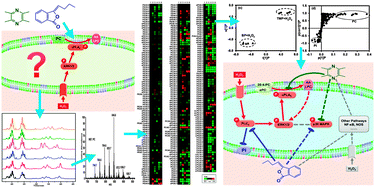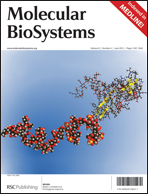Integrated investigation of lipidome and related signaling pathways uncovers molecular mechanisms of tetramethylpyrazine and butylidenephthalide protecting endothelial cells under oxidative stress†
Abstract
Tetramethylpyrazine (TMP) and butylidenephthalide (BP) are two bioactive components isolated from Ligusticum chuanxiong Hort and Angelica sinensis, respectively. These two traditional Chinese medicines have been widely used in clinical treatments for vascular disease. The mechanism by which TMP and BP protect endothelial cells (ECs) against oxidative stress remains unknown, as does their effects on the steady state of the lipidome of ECs. Here, we demonstrate that both compounds protect EA.hy926 cells against H2O2 induced injury in a dose-dependent manner. We then apply an integrated analysis of the lipidome and signal transduction pathways to explore the underlying mechanism of their protective effects. We found that TMP elevates the content of several phosphatidylcholine (PC) species, reduces the release of arachidonic acid (AA) and inhibits the phosphorylation of cytosolic phospholipase A2 (cPLA2). Compared to eicosatetraynoic acid (ETYA), a cPLA2 inhibitor, TMP preferentially increases the content of arachidonoyl PCs. We also show that BP mainly elevates the pool of phosphatidylinositol (PI) species and inhibits the phosphorylation of both phospholipase Cγ (PLCγ) and extracellular signal-regulated kinase 1/2 (ERK1/2). In contrast, specific inhibition of ERK1/2 by PD98059 decreases the cell viability and increases pool of phosphatidylserine (PS). Taken together, these results demonstrate that TMP protects oxidatively stressed ECs through inhibition of cPLA2 and preferential increase of arachidonoyl PC levels. Conversely, the effects of BP are tied to inhibition of PLCγ and an increase in PI levels. The current work suggests that the interaction of the lipidome and phospholipases can serve as a promising therapeutic target in oxidatively stressed ECs.


 Please wait while we load your content...
Please wait while we load your content...